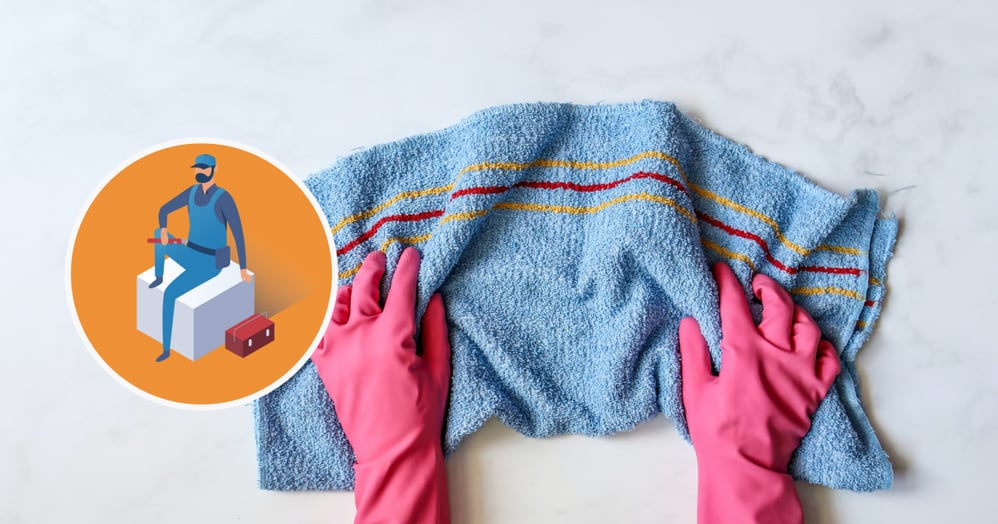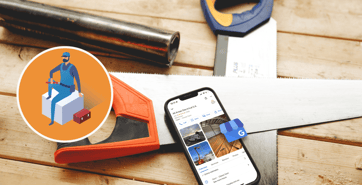Cleaning Business Start-Up Costs - Your Guide to a Cleaner’s Expenses
by Team Tradify, March 22, 2023

Table of Contents
In our busy world, cleaning is something many people don’t have time to do themselves. That’s good news for cleaners and entrepreneurs. Starting your own cleaning business comes with various start-up costs, anywhere from three to six figures depending on your services, location, and bigger investments like a work vehicle. Here are the six essential expenses you should factor into your budget.
Do you know what you need to charge in order to turn a profit? If not, try our free charge out rate calculator for cleaning businesses!
Short on time? Skip ahead!
- 1. Digital tools
- 2. Materials for jobs
- 3. Insurance
- 4. Vehicle
- 5. Marketing & advertising
- 6. Legal costs
- 7. Job management software
1. Digital tools
Starting your own cleaning business takes a lot of time and energy. The last thing you want to worry about is a missing invoice or unprofessional quote. It’s why investing in accounting software from the get-go is non-negotiable. It’s a small cost that could save you thousands in time and money, help you manage cash flow, and ensure your invoices are delivered and paid on time.
Job management software like Tradify is built especially for people in your industry, making it easy to store quotes, enquiries, and job information all in one place. You can throw together professional quotes, chase overdue payments and flick off invoices in minutes, as well as integrate other accounting packages and save on hiring an accountant straight away.
Here's what you can expect to pay (on average) for job management and accounting software annually at the time of writing:
- 🇺🇸 USA - $700–800
- 🇬🇧 UK - £350–450
- 🇦🇺 AU - $650–750
- 🇳🇿 NZ - $700–800
2. Materials for jobs
A job's end result largely depends on the quality of the materials you use. You don’t want to risk turning up to your first job ill-prepared, chasing supplies while you’re on the job will only dig into your valuable time.
The materials you’ll need will depend on what type of cleaning you specialise in (residential or commercial, for example). But you’ll at least want to make sure you’re prepared with the essentials:
Cleaning tools
- A good quality vacuum, mop, and bucket.
- Industrial cleaning chemicals: carpet cleaner, oven cleaner, floor scrubber, floor polisher, etc.
Cleaning materials
- Colour-coded cloths for different areas such as kitchens, bathrooms, and general living spaces.
- Cleaning products such as multipurpose spray, shower cleaners, and disinfectants.
- Cleaning products like multipurpose spray, shower cleaner, and disinfectants.
- PPE, including gloves, shoe covers, coveralls, masks, and protective eyewear.
- First Aid, including eye rinses, burn cream, bandages, painkillers, etc.
It might seem like a lot to invest in before you’ve got so much as your first booking, so make sure to factor in these costs when calculating your charge-out rate.
Don’t forget, business expenses are tax-deductible. Here’s how to claim them back:
- 🇬🇧 UK
- 🇦🇺 Australia
- 🇳🇿 New Zealand
3. Insurance
Although it’s not a legal requirement, insurance could save your cleaning business in instances where a client’s property is damaged, or if your equipment goes walkabout.
Here are the main ones you might need:
- Public liability insurance - covers you if your company causes injury or property damage. If a claim is successful, the insurance will pay out.
- Tools and equipment cover - one of the most significant financial outlays when starting a cleaning business must be protected against loss or damage.
- Income protection - will kick in if you get sick or injured and can’t work for a while.
- Employer’s liability insurance - if you hire employees or an apprentice, you need specific insurance to cover them.
- Vehicle insurance - your work vehicle must also be insured under your business.
Insurance isn’t a one-size-fits-all, so it’s important to sit down with an authorised business insurance broker to ensure you’ve got your bases covered.
4. Vehicle
It’s unlikely that all your jobs will be on the same street, and you’ll need some wheels to help transport you and all your gear to each job. Unless you’ve got a two-seater hatchback or no car at all, whatever vehicle you currently use should do the trick to save forking out initially.
Just make sure it fits the criteria:
- It has enough room for all your equipment. Vacuum, mop, buckets, and brushes, with enough space to comfortably store bottles of cleaning products so they don’t spill.
- It doesn’t need to be fancy, but it should look the part. Ensure your work vehicle is tidy and professional — you might even want to consider vehicle signwriting (another business expense you can claim).
If your current vehicle doesn’t tick these boxes, the cost of a new or second-hand vehicle must be factored into your start-up budget. At the time of writing, here’s roughly what you can expect to pay for a decent ride:
- 🇺🇸 USA - $6,000–40,000
- 🇬🇧 UK - £4,000–35,000
- 🇦🇺 AU - $8,000–60,000
- 🇳🇿 NZ - $10,000–60,000
5. Marketing and advertising
Starting a successful cleaning business involves getting your name out there, building a great reputation and forming relationships with new customers. But you need to get your first customer from somewhere, and that comes down to marketing your new business. The first step is a solid marketing plan. We’ve created a free template for creating the perfect cleaning business marketing plan.
Once you’re in the swing of business and turning a profit, it’s a good idea to ramp up the marketing to grow business even further — expect to spend 2–5% of your gross annual revenue on marketing and advertising, as a rule of thumb.
Here are some additional marketing ideas to suit both small and larger budgets:
Word of mouth
Don’t underestimate the power of a recommendation. It’s how 74% of consumers find companies. So, next time you pick the kids up from school or you’re at your neighbourhood BBQ, spread the word about your services. You never know who might be listening. The best thing? It won’t cost you a cent.
Social media
The beauty of social media is that it can quickly become the number one way to spread the word about your brand without breaking the bank.
A professional and crisp Instagram page can reach the smartphones of thousands of people, and you can typically create targeted ads to reach a specific audience for less than a tenner.
Website
Efficient and well-planned digital marketing is crucial to the success of any business, but you don’t need to blow your whole budget when you’re just starting out.
Kickstarting your digital marketing is as easy as jumping on Tradify’s website builder to create a simple, effective website yourself. Simply follow our pointers and you’ll quickly go live with all the important information your customers need to know about you. Check out our guide to digital marketing for more tips,
Branding
A successful cleaning company needs a crisp brand identity, which means creating a business name, logo, company colours, and a general look and feel to inspire your marketing. Thankfully, with some help from Canva or Fiverr, none of this needs to cost much — and you might even be able to do most of it for free.
If you still need a name for your brand, try our free cleaning business name generator!
6. Legal costs
You don’t need specific qualifications or certificates to start a cleaning business. Still, you’ll need to complete the appropriate paperwork to get your business underway, like choosing a name and registering your business.
The ballpark costs for registering your business at the time of writing are:
- 🇬🇧 UK - £12–40
- 🇺🇸 USA - $600–1,400
- 🇦🇺 AU - $440–530
- 🇳🇿 NZ - $115
7. Save time and money with job management software
Starting your own cleaning business takes guts, hard work, and a good understanding of essential start-up costs. Effective admin solutions like Tradify can help get your business started on the front foot by streamlining business processes, eliminating admin headaches, and affording you more time to focus on what’s important — securing work and growing business.
Try Tradify for free, or pop over to one of our live demo webinars to see it in action.
Related articles

How To Set Up a Google Business Profile (for Trade Businesses)

Aussie Electrician Reduces Admin Time by 95%

Squeaky Clean Scheduling for Pro Carpet Cleaning
Give Tradify a go for free!
Save 10+ hours/week on business admin with the highest-rated job management software for tradespeople.
With free one-on-one training and phone support, it's never been easier to get started.





